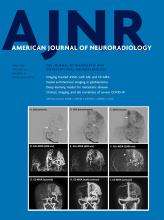Abstract
BACKGROUND AND PURPOSE: Cervical spine axial MRI T2-hyperintense fluid signal of the anterior median fissure and round hyperintense foci resembling either the central canal or base of the anterior median fissure are associated with a craniocaudad sagittal line, also simulating the central canal. On the basis of empiric observation, we hypothesized that hyperintense foci, the anterior median fissure, and the sagittal line are seen more frequently in patients with Chiari malformation type I, and the sagittal line may be the base of the anterior median fissure in some patients.
MATERIALS AND METHODS: Saggital line incidence and the incidence/frequency of hyperintense foci and anterior median fissure in 25 patients with Chiari I malformation and 25 contemporaneous age-matched controls were recorded in this prospective exploratory study as either combined (hyperintense foci+anterior median fissure in the same patient), connected (anterior median fissure extending to and appearing to be connected with hyperintense foci), or alone as hyperintense foci or an anterior median fissure. Hyperintense foci and anterior median fissure/patient, hyperintense foci/anterior median fissure ratios, and anterior median fissure extending to and appearing to be connected with hyperintense foci were compared in all, in hyperintense foci+anterior median fissure in the same patient, and in anterior median fissure extending to and appearing to be connected with hyperintense foci in patients with Chiari I malformation and controls.
RESULTS: Increased sagittal line incidence (56%), hyperintense foci (8.5/patient), and anterior median fissure (4.0/patient) frequency were identified in patients with Chiari I malformation versus controls (28%, 3.9/patient, and 2.7/patient, respectively). Increased anterior median fissure/patient, decreasing hyperintense foci/anterior median fissure ratio, and increasing anterior median fissure extending to and appearing to be connected with hyperintense foci/patient were identified in Chiari subgroups. A 21%–58% increase in observed anterior median fissure extending to and appearing connected to hyperintense foci in the entire cohort and multiple sagittal line subgroups compared with predicted occurred.
CONCLUSIONS: In addition to the anticipated increased incidence/frequency of sagittal line and hyperintense foci in patients with Chiari I malformation, an increased incidence and frequency of anterior median fissure and anterior median fissure extending to and appearing to be connected with hyperintense foci/patient were identified. We believe an anterior median fissure may contribute to a saggital line appearance in some patients with Chiari I malformation. While thin saggital line channels are usually ascribed to the central canal, we believe some may be due to the base of the anterior median fissure, created by pulsatile CSF hydrodynamics.
ABBREVIATIONS:
- AMF
- anterior median fissure
- AMF>HIF
- anterior median fissure extending to and appearing to be connected with hyperintense foci
- CTM
- CT myelography
- HIF
- hyperintense foci
- HIF+AMF
- hyperintense foci and anterior median fissure in the same patient
- pt.
- patient
- SL
- sagittal line
- © 2021 by American Journal of Neuroradiology












